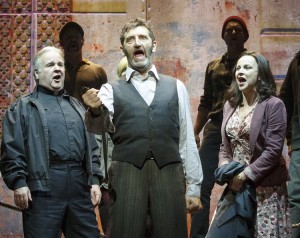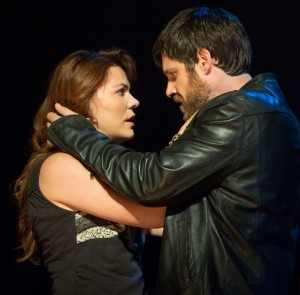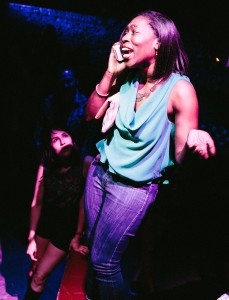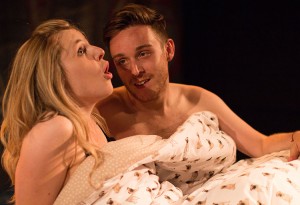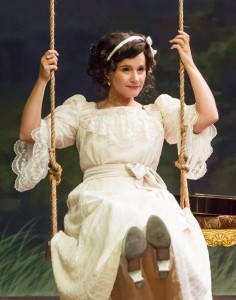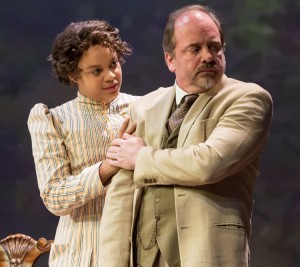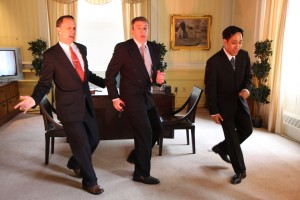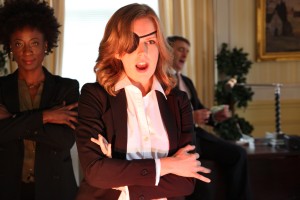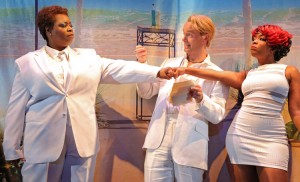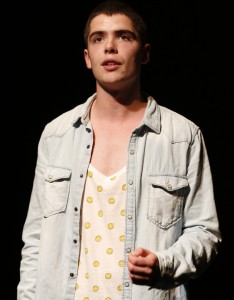One of August Strindberg’s most famous plays, Miss Julie, has been widely produced and adapted around the world. Recently, August Strindberg Repertory Theatre has kept the play in the year 1888, but relocated it from a farmhouse in Sweden to a plantation house in antebellum Louisiana. Also, this version of Miss Julie takes place on the bacchanalian occasion of Mardis Gras. Edgar Chisholm’s adaptation of language in the script makes this production’s geographical relocation work well, as does the costume design by Marisa Ferrara. On the other hand, some of the confusing directorial and acting decisions pull this production in another, more discordant, direction.
There are several key visual moments emblematic of Strindberg’s Miss Julie, and this production’s greatest strength lies in the fact that it highlights them all without being fussy or contrived. In fact, director Robert Greer subtly seems to slow down time with the boot-kissing scene; the image of John (played by Reginald L. Wilson) slowly pressing his lips to the extended boot of Julie (played by Ivette Dumeng) is both erotic and disturbing. Other well-done iconic moments are the placement of the master’s boots and coat prominently so that they oppressively loom with his presence from slightly upstage, and John’s beheading of Julie’s bird at the end of the play. With these moments in mind, it is clear that both director and production team have done their homework, and they succeed in capturing Strindberg’s quintessential staging moments without overdoing them.
 On the other hand, there is one moment that is less popular in the production history of Miss Julie: the interim ballet. According to Strinberg’s original stage directions, this strange interlude involves a parade of peasants that pours into the kitchen while John and Julie abscond into his room to have sex. Meant to evoke and eclipse the main characters’ illicit sex act, this weird sequence is often eschewed by contemporary directors who seek to maintain the play’s naturalistic core. Strindberg Rep has decided to stage the ballet, but in a contemporary fashion in a sequence choreographed by Ja’ Malik. Rather than have a whole troupe of peasants invade the kitchen, Malik has choreographed a sexually-charged dance for two. While dancers Alison MacDonald and Brian Binion are strong, beautiful, and talented, their choreography is much too literal. Their sequence eventually culminates in faux-fornication atop the kitchen table. Awkward and clearly fake, this choreographic choice mostly defeats the suggestive potential of dance and robs the sequence of its mystery and eroticism.
On the other hand, there is one moment that is less popular in the production history of Miss Julie: the interim ballet. According to Strinberg’s original stage directions, this strange interlude involves a parade of peasants that pours into the kitchen while John and Julie abscond into his room to have sex. Meant to evoke and eclipse the main characters’ illicit sex act, this weird sequence is often eschewed by contemporary directors who seek to maintain the play’s naturalistic core. Strindberg Rep has decided to stage the ballet, but in a contemporary fashion in a sequence choreographed by Ja’ Malik. Rather than have a whole troupe of peasants invade the kitchen, Malik has choreographed a sexually-charged dance for two. While dancers Alison MacDonald and Brian Binion are strong, beautiful, and talented, their choreography is much too literal. Their sequence eventually culminates in faux-fornication atop the kitchen table. Awkward and clearly fake, this choreographic choice mostly defeats the suggestive potential of dance and robs the sequence of its mystery and eroticism.
In his preface to the play, Strindberg described the titular character in his preface to Miss Julie as a “a victim of the errors of an age, of circumstances, and of her own deficient constitution.” While Dumeng certainly victimizes Julie as deficient and tortured, I wish that Greer had encouraged Dumeng to harness more of an internal power and tension – a tension that must be present for Julie to believably “snap” in the end. Furthermore, the lack of tangible passion between Julie and John makes their night of passion seem contrived. With the exception of a few too contemporary sleights of speech, Wilson nails his southern accent, but Dumeng’s accent distracts by sounding affected and inconsistent. Eboni Flowers stands out in the small but powerful part of Christine: her physical poise and vocal conviction make Strindberg’s character truly shine.
Overall, this is a clean production in the sense that it honors and perfects Miss Julie’s classic moments. The interim ballet is commendable in its experimental spirit, but its literalness falls short of real eroticism. The acting is strong in moments, but the developmental arc of John and Julie’s romance needs more detailing. For those interested in Miss Julie, its adaptations, and its history, this production is definitely worth seeing.
Miss Julie runs to November 8, 2014 at the Gene Frankel Theatre on 24 Bond Street (between Bowery and Lafayette in the East Village). Shows are Tuesdays through Saturdays at 8 p.m. and Sundays at 1:30 p.m. Tickets are $18 general admission; seniors and students $12; student groups $9. You can buy tickets by calling SMARTTIX at 212-868-4444 or at www.smarttix.com.








